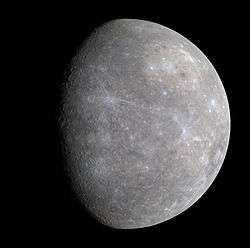Scarlatti (crater)
|
Photo of Scarlatti crater (above the center) by MESSENGER | |
| Planet | Mercury |
|---|---|
| Coordinates | 40°30′N 100°00′W / 40.5°N 100°WCoordinates: 40°30′N 100°00′W / 40.5°N 100°W |
| Diameter | 129 km[1] |
| Eponym | Domenico Scarlatti and Alessandro Scarlatti [2] |
Scarlatti is a pit-floored crater on Mercury, which was discovered in 1974 by Mariner 10 spacecraft.[1] It has a prominent peak ring, which floor is covered by the smooth plain material. The crater displays an arcuate collapse feature (central pit) along the peak ring. The size of the pit, which was first noticed in MESSENGER images obtained in January 2008, is 38 × 12 km.[1] Such a feature may have resulted from collapse of a magma chamber underlying the central peak ring complex of the crater. The collapse feature is an analog of Earth's volcanic calderas. Scarlatti is thought to have the same age as the Caloris basin.[1]
References
- 1 2 3 4 Gillis-Davis, Jeffrey J.; Blewett, David T.; Gaskell, Robert W.; Denevi, Brett W.; Robinson, Mark S.; Strom, Robert G.; Solomon, Sean C.; Sprague, Ann L. (2009). "Pit-floor craters on Mercury: Evidence of near-surface igneous activity". Earth and Planetary Science Letters. 285 (3-4): 243–250. Bibcode:2009E&PSL.285..243G. doi:10.1016/j.epsl.2009.05.023.
- ↑ "Mercury: Scarlatti". USGS. Retrieved November 19, 2009.
This article is issued from Wikipedia - version of the 11/18/2016. The text is available under the Creative Commons Attribution/Share Alike but additional terms may apply for the media files.
_enh.jpg)
